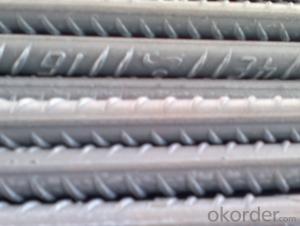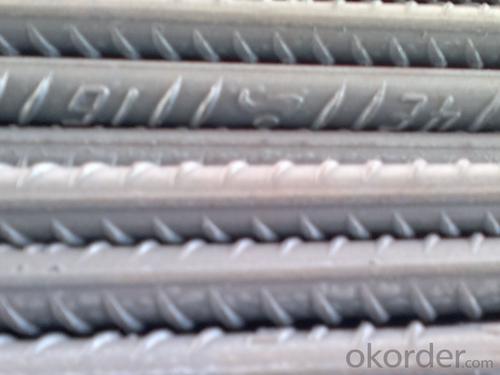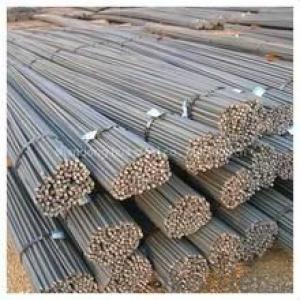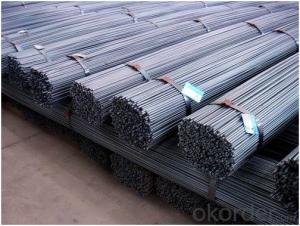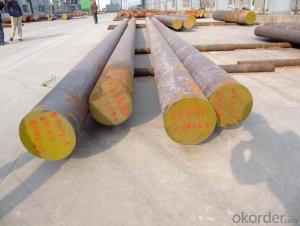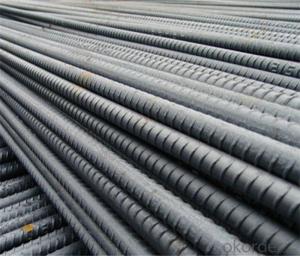Steel Rebars,Deformed Steel Bars,Building Material China Manufacturer
- Loading Port:
- Tianjin
- Payment Terms:
- TT or LC
- Min Order Qty:
- 50 m.t.
- Supply Capability:
- 20000 m.t./month
OKorder Service Pledge
OKorder Financial Service
You Might Also Like
Product Description:
OKorder is offering Steel Rebars,Deformed Steel Bars,Building Material China Manufacturer at great prices with worldwide shipping. Our supplier is a world-class manufacturer of steel, with our products utilized the world over. OKorder annually supplies products to European, North American and Asian markets. We provide quotations within 24 hours of receiving an inquiry and guarantee competitive prices.
Product Applications:
Steel Rebars,Deformed Steel Bars,Building Material China Manufacturer are ideal for structural applications and are widely used in the construction of buildings and bridges, and the manufacturing, petrochemical, and transportation industries.
Product Advantages:
OKorder's Steel Rebars,Deformed Steel Bars,Building Material China Manufacturer are durable, strong, and resist corrosion.
Main Product Features:
· Premium quality
· Prompt delivery & seaworthy packing (30 days after receiving deposit)
· Corrosion resistance
· Can be recycled and reused
· Mill test certification
· Professional Service
· Competitive pricing
Product Specifications:
Manufacture: Hot rolled
Grade: HRB335
Certificates: ISO, SGS, BV, CIQ
Length: 6m – 12m, as per customer request
Packing details Steel:Steel rebar packed in bundle or as your requirement
Delivery:Within 30 days after deposit
Diameter:10mm-40mm
Place of Origin:Fujian, China (Mainland)
Model Number:QZMM-ST001
Application:Building material, construction, road, bridge,etc
Product Name:Steel Rebars,Deformed Steel Bars,Building Material China Manufacturer
Standard:ASTM A615 /BS BS 4449 /GB HRB/ JIS G3112
Material:HRB335
Shape:Straight reinforcing bars
Technique:Low temperature hot-rolling reinforcing deformed steel rebar
Tolerance:As the standard or as your requirement
MOQ:100tons per size steel rebar
Packing details Steel:Steel rebar packed in bundle or as your requirement
Delivery:Within 30 days after deposit
Post:XIAMEN,CHINA
FAQ:
Q1: How soon can we receive the product after purchase?
A1: Within three days of placing an order, we will begin production. The specific shipping date is dependent upon international and government factors, but is typically 7 to 10 workdays.
Q2: What makes stainless steel stainless?
A2: Stainless steel must contain at least 10.5 % chromium. It is this element that reacts with the oxygen in the air to form a complex chrome-oxide surface layer that is invisible but strong enough to prevent further oxygen from "staining" (rusting) the surface. Higher levels of chromium and the addition of other alloying elements such as nickel and molybdenum enhance this surface layer and improve the corrosion resistance of the stainless material.
Q3: Can stainless steel rust?
A3: Stainless does not "rust" as you think of regular steel rusting with a red oxide on the surface that flakes off. If you see red rust it is probably due to some iron particles that have contaminated the surface of the stainless steel and it is these iron particles that are rusting. Look at the source of the rusting and see if you can remove it from the surface.
Images:
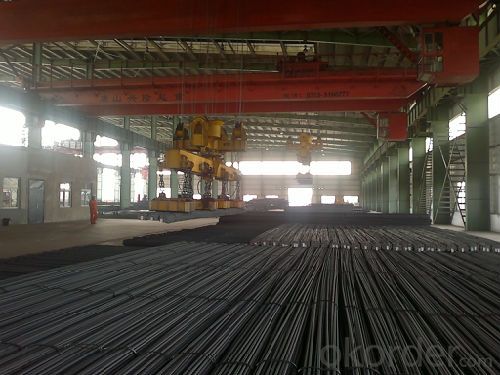
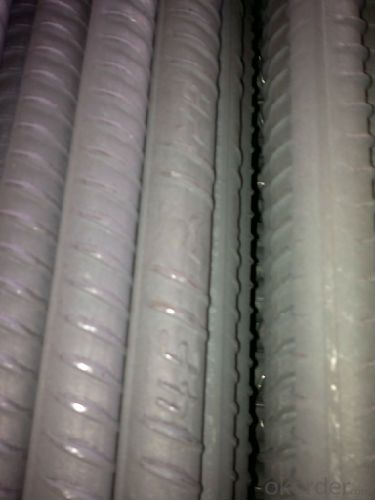
- Q: How do steel rebars affect the fire resistance of concrete structures?
- Steel rebars can significantly enhance the fire resistance of concrete structures. The presence of steel rebars in concrete acts as reinforcement, providing added strength and stability to the structure. This reinforcement helps the concrete withstand the intense heat generated during a fire. The fire resistance of concrete structures is primarily due to the low thermal conductivity of concrete. When exposed to high temperatures, concrete undergoes a process called spalling, where the outer layer of the concrete breaks off due to the rapid expansion of water trapped within. However, the presence of steel rebars helps minimize spalling by holding the concrete together, preventing it from falling apart. Furthermore, steel rebars have a higher melting point compared to concrete. This means that even when exposed to extreme heat, the steel rebars retain their strength and integrity. As a result, the overall structural stability of the concrete structure is maintained, even under fire conditions. Steel rebars also act as a heat sink, absorbing and dissipating heat away from the surrounding concrete. This heat dissipation prevents localized hotspots from forming and spreading throughout the structure, minimizing the risk of structural failure. To improve the fire resistance of concrete structures further, special types of steel rebars, known as fire-resistant or fire-rated rebars, can be used. These rebars are specifically designed to withstand high temperatures for extended periods without losing their strength. They are often coated with materials such as epoxy or intumescent coatings that provide additional protection against fire. In conclusion, steel rebars play a crucial role in enhancing the fire resistance of concrete structures. Their presence improves the overall structural stability, minimizes spalling, dissipates heat, and provides added strength to withstand the intense heat generated during a fire.
- Q: Why the longitudinal tie bar adopts screw steel bar, and the transverse transmission bar adopts light round steel bar.
- Longitudinal tie rod. Longitudinal seam usually has longitudinal contraction joint and longitudinal construction joint two kinds, two kinds of longitudinal joints should be provided with tie rod. The bar shall be designed with the length of the threaded steel to ensure the bond between it and the concrete, and the diameter and spacing of the tie rod shall also be guaranteed. Thus, the tie rod can not provide enough tensile force, and when the concrete faceplate is contracted, the longitudinal joint is pulled apart to form a crack.
- Q: How do steel rebars affect the durability of concrete in freeze-thaw cycles?
- Steel rebars can significantly improve the durability of concrete in freeze-thaw cycles. Due to their high tensile strength and ability to resist corrosion, rebars enhance the structural integrity of concrete by providing reinforcement and preventing cracking. By effectively distributing the tensile stresses caused by freeze-thaw cycles, steel rebars help to maintain the overall stability and longevity of the concrete structure.
- Q: Can steel rebars be used in the construction of hotels and resorts?
- Yes, steel rebars can be used in the construction of hotels and resorts. Steel rebars are commonly used as reinforcement in concrete structures to provide strength and durability. In the construction of hotels and resorts, where large-scale and high-quality structures are required, steel rebars are often used to ensure the safety and stability of the buildings.
- Q: Can steel rebars be used in railway bridge construction?
- Yes, steel rebars can be used in railway bridge construction. Steel rebars are commonly used in the construction industry for reinforcing concrete structures, including bridges. Railway bridges often require a high level of strength and durability to support heavy loads and withstand the constant vibrations and stresses caused by passing trains. Steel rebars provide the necessary reinforcement to concrete structures, enhancing their load-bearing capacity and ensuring the bridge's long-term structural integrity. Additionally, steel rebars can be easily customized to meet the specific design requirements of railway bridges, making them a suitable choice for construction in this context.
- Q: What are the common manufacturing processes for steel rebars?
- Steel rebars are manufactured through a series of steps to guarantee the production of durable and high-quality reinforcement bars. These steps usually consist of the following: 1. Melting: Initially, raw materials such as iron ore, coal, and limestone are melted in a blast furnace. This process yields molten iron, which is further refined to eliminate impurities. 2. Casting: Subsequently, the refined molten iron is poured into molds, creating large billets or blooms. These molds, commonly known as continuous casting machines, solidify the molten iron into a rectangular form. 3. Rolling: The solidified billets or blooms are then heated and passed through rolling mills. Through this rolling process, the steel is compressed between a series of rollers, reducing its thickness and shaping it into the desired dimensions of rebars. Additionally, this process enhances the mechanical properties of the steel while eliminating any internal defects or impurities. 4. Quenching and Tempering: Following the initial rolling, the rebars may undergo quenching and tempering. Quenching involves rapidly cooling the steel bars by immersing them in water or oil. This step increases the hardness of the rebars, making them more resistant to deformation and wear. Subsequently, tempering involves reheating the quenched bars to a specific temperature and gradually cooling them. This process eliminates internal stresses and improves the toughness of the rebars. 5. Cutting and Coiling: Once the rebars have been rolled and heat-treated, they are cut to the desired lengths using cutting machines. The cut rebars are then either coiled into bundles or stacked for storage and transportation. 6. Surface Treatment: Manufacturers often apply a protective coating or surface treatment to enhance the corrosion resistance of rebars. This can be achieved through hot-dip galvanizing, where the rebars are immersed in molten zinc to form a zinc coating, or epoxy coating, where a layer of epoxy resin is applied to the rebars. It is crucial to note that these manufacturing processes may vary depending on the specific requirements and standards set by different countries and industries. Nevertheless, the aforementioned steps provide a general overview of the common processes involved in manufacturing steel rebars.
- Q: What is the process of installing steel rebars in slabs and beams?
- The process of installing steel rebars in slabs and beams involves several steps. Firstly, the design and layout of the rebars are determined based on the structural requirements. The rebars are then cut, bent, and shaped according to the specifications. Next, the concrete forms for the slabs and beams are prepared, ensuring they are clean and properly aligned. Once the forms are ready, the rebars are placed inside the forms in the desired positions, maintaining the required spacing and clearances as per the design. Proper support is provided to hold the rebars in place and prevent displacement during the concrete pouring process. After the rebars are correctly positioned, concrete is poured into the forms, covering the rebars entirely. During pouring, care is taken to ensure that the concrete adequately surrounds and encases the rebars, providing the necessary structural integrity. Finally, the concrete is allowed to cure and harden, creating a strong bond with the rebars. Once the concrete has fully cured, the forms are removed, and any excess concrete or debris is cleaned off the surface. Overall, the process of installing steel rebars in slabs and beams involves careful planning, precise positioning, and proper concrete placement to create a reinforced structure that can withstand the intended loads and stresses.
- Q: Are there any specific safety measures to be taken while working with steel rebars?
- Yes, there are several specific safety measures to be taken while working with steel rebars. These include wearing appropriate personal protective equipment such as gloves, safety glasses, and steel-toed boots to protect against cuts, eye injuries, and foot injuries. It is also important to ensure that the work area is well-lit and free from tripping hazards. Workers should be trained in proper handling techniques to avoid strains and sprains, and should never carry or drag rebars by hand. Additionally, it is crucial to use the correct tools for cutting and bending rebars and to follow safe lifting practices to prevent back injuries. Regular inspections of the rebars for damage or defects should also be conducted to maintain a safe working environment.
- Q: How are steel rebars manufactured?
- Steel rebars are manufactured through a process called hot rolling, where billets of steel are heated and passed through rollers to shape them into the desired rebar form. This is followed by a cooling process and then cutting them into appropriate lengths.
- Q: Can steel rebars be used in railway bridge construction?
- Absolutely, railway bridge construction can utilize steel rebars. In the construction sector, steel rebars are frequently employed to strengthen concrete structures, such as bridges. Railway bridges necessitate exceptional strength and durability to endure heavy loads, continual vibrations, and strains triggered by passing trains. By reinforcing concrete structures, steel rebars augment their ability to bear loads and safeguard the long-term structural soundness of the bridge. Furthermore, steel rebars can be readily tailored to cater to the precise design prerequisites of railway bridges, making them a fitting option for construction in this particular setting.
Send your message to us
Steel Rebars,Deformed Steel Bars,Building Material China Manufacturer
- Loading Port:
- Tianjin
- Payment Terms:
- TT or LC
- Min Order Qty:
- 50 m.t.
- Supply Capability:
- 20000 m.t./month
OKorder Service Pledge
OKorder Financial Service
Similar products
Hot products
Hot Searches
Related keywords
